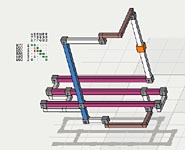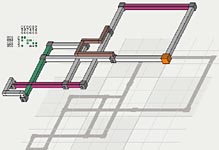Steve K wrote:Denis, I understand that you can provide numerous counter examples to your mapping. Do you have one for my mapping of nrctz into TM written above?
- Code: Select all
A chain of n "cells" maps into an nxn TM.
"cell" m maps into TM row m.
Right-most "cell" content for all "cells" except "cell" n maps into TM row m, column m+1.
"Cell" content that "sees" the target are placed in TM column 1.
"Cell" content for row j (j>m)that is "linked" to right-most "cell" content for "cell" m is placed in TM column m+1.
TM entries which have not been filled are left empty.
I have placed each sentence on a new line, for clarity. Admittedly, I should have used symbols more judiciously. However, I think each line is clear by itself in directing the mapping.
As I indicated at the end of my post, I have no counter-example if you put subsets in the matrix cells - and, as I already stated also, I'm not interested in so overly general structures.
Putting the sentences in separate lines doesn't make it clearer that cell contents are subsets.
Whichever way you try to write it, whichever way you change my vocabulary of left-linking, right-linking, z- and t- candidates, you need the explicit definition of an nrczt-chain before you can define your mapping and the corresponding subset of TMs.
If this can make you happy, it is likely that your extended TMs are more general than nrczt-chains - but that's completely besides the initial point, because more general doesn't mean you knew the interesting special case of nrczt-chains before it was defined. Otherwise, I can say that with my Universal Algorithm, I know everything that has or will ever be written.
Steve K wrote:It is common practice in mathematics, unless I am mistaken, that if something is not explicity forbidden, then it is acceptable.
I guess you don't have much practice of maths, so you shouldn't speak of common practice. In maths, you give a definition and you respect 100% of it, no more no less - you don't have to add or delete conditions.
In your "definition", Paris monuments are not explicitly forbidden in the cells. Should they be allowed?
Steve K wrote:Thus, I cannot see how your mapping and mine are equivalent. Did you intend your mapping to be equivalent to mine?
I devised my mapping before you wrote yours, when I still thought a cell entry was a candidate, and when I published it later I suggested that "they are more or less equivalent" (if cells are candidates and not subsets); I said "more or less" because rows are displaced by 1. If the entries are subsets, they are obviously not equivalent.
Steve K wrote:IMO, all counter examples to your mapping employ the use of a candidate box/row or a candidate box/column intersection. Is this correct?
Obviously yes. Notice that this restriction on the types of subsets that can be used as entries was not stated in your extended definition of TMs. So that this is one more constraint you have to put on them in order to get them closer to nrczt-chains.



